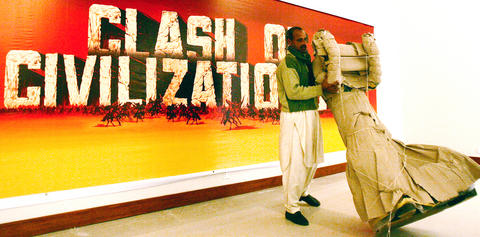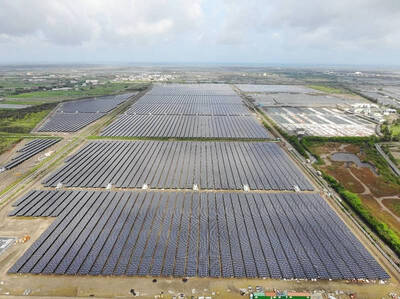Pakistan's painstakingly built National Art Gallery has overcome decades of political turbulence to become an eye-catching symbol of modernity and creativity in a Muslim nation long haunted by religious conservatism.
The four-story gallery opened to the public Tuesday with an expansive exhibit of 600 works - from Persian-style miniature paintings with a modern twist to large-scale sculpture created specially for the site.
Pakistan has long had a vibrant, if small, art scene, but the gallery took more than a quarter-century from conception to completion due mainly to the changing priorities of a series of military leaders and short-lived elected governments.

PHOTO: AFP
"It's a wonderful feeling to have a home for all the work - a place to house the work of three generations of artists,'' said Naiza Khan, a curator of the inaugural show and a Karachi-based artist whose female metal body armor is also on display.
Featuring work from 126 Pakistani artists, some of the pieces in the Moving Ahead show have a distinctly South Asian or Islamic flavor - Arabic calligraphy, a painting with Bollywood actors or a throne made of white plastic ablution buckets that Muslims used to wash before prayer.
The works in the show are owned by the Pakistan National Council of the Arts or on loan from private collectors.
There are miniature paintings with a globalized twist. One work by Waseem Ahmed, entitled Burqa, transforms a classical European odalisque into this classical Persian form. The reclining Venus is draped in a gauzy, transparent burqa - an all-covering Islamic veil - and gazes into a mirror that reflects apples, the classic Christian symbol of temptation.
One of the 12,000m2 gallery's two grand halls holds several sculptures, including one that artist Khalil Chishtee created using white plastic bags - a woman walking a tightrope, with a man below with his head turned up toward her, apparently held in position by a thread tugging his nose skyward.
The interior space is white with warm accents such as a brick-paved ramp leading to the mezzanine, and a few areas with wood detailing on the ceiling. An auditorium and a rooftop courtyard are surrounded by delicate arches.
The exterior is made almost entirely of brick - a rare choice in an era of new museums around the world constructed with concrete.
"Brick has a humility. It has a scale that is so intimate,'' said the architect, Naeem Pasha.
Some spaces, such as the room showing the calligraphy, are one-story high, while others are two stories high or even larger, including a ground-floor room that can be viewed from two little balconies on the second floor to give the viewer a different perspective.
Pasha won the first competition to choose an architect in 1981, but there were many hiccups thereafter - often because of the frequent changes of government - including a site switch because the original location was used for the prime minister's secretariat.
The foundation stone was laid in March 1996, but funding was then diverted to construct a convention center for an Islamic summit held in 1997, he said.
Some officials even wanted to shelve the project and demolish the unfinished structure because they worried it could be a hiding place for snipers targeting President General Pervez Musharraf, whose office is nearby, he said.
Set near the country's Parliament and government offices, the US$8.9 million gallery creates a rare cultural outlet and attraction for visitors in Pakistan's grid-plan capital, which was only built in the 1960s.
There are outdoor shopping centers, parks and the impressive Lok Virsa ethnographic museum, but few places to see art or theater - long seen as the arena of Lahore, the cultural capital of Pakistan.
The gallery and artwork on show are indicative of how secular and liberal Pakistan's growing middle-class has become, despite the conservative influence of the religious establishment.
Musharraf, burnishing his credentials as a moderate in the midst of a bumpy re-election drive, spoke at a weekend opening event for the gallery of the need "to project a soft, peaceful and tolerant image of Pakistan.''
The Ministry of Culture had promised there will be no censorship, said Salima Hashmi, one of the curators and a Lahore-based art historian. They were told to exercise their own judgment so as not to offend anyone.
Showing figurative work or nudes "would be a problem in certain venues in Pakistan that are more conservative - Peshawar, for example,'' near the Afghan border, Hashmi said.
"As in many countries, you have audiences which will accept work which seems to be pushing the boundaries, and there will be other conservative audiences that will simply not accept it.''
On the Net: For the Pakistan National Council of the Arts, visit pnca.com.pk/

With one week left until election day, the drama is high in the race for the Chinese Nationalist Party (KMT) chair. The race is still potentially wide open between the three frontrunners. The most accurate poll is done by Apollo Survey & Research Co (艾普羅民調公司), which was conducted a week and a half ago with two-thirds of the respondents party members, who are the only ones eligible to vote. For details on the candidates, check the Oct. 4 edition of this column, “A look at the KMT chair candidates” on page 12. The popular frontrunner was 56-year-old Cheng Li-wun (鄭麗文)

“How China Threatens to Force Taiwan Into a Total Blackout” screamed a Wall Street Journal (WSJ) headline last week, yet another of the endless clickbait examples of the energy threat via blockade that doesn’t exist. Since the headline is recycled, I will recycle the rebuttal: once industrial power demand collapses (there’s a blockade so trade is gone, remember?) “a handful of shops and factories could run for months on coal and renewables, as Ko Yun-ling (柯昀伶) and Chao Chia-wei (趙家緯) pointed out in a piece at Taiwan Insight earlier this year.” Sadly, the existence of these facts will not stop the

Oct. 13 to Oct. 19 When ordered to resign from her teaching position in June 1928 due to her husband’s anti-colonial activities, Lin Shih-hao (林氏好) refused to back down. The next day, she still showed up at Tainan Second Preschool, where she was warned that she would be fired if she didn’t comply. Lin continued to ignore the orders and was eventually let go without severance — even losing her pay for that month. Rather than despairing, she found a non-government job and even joined her husband Lu Ping-ting’s (盧丙丁) non-violent resistance and labor rights movements. When the government’s 1931 crackdown

The first Monopoly set I ever owned was the one everyone had — the classic edition with Mr Monopoly on the box. I bought it as a souvenir on holiday in my 30s. Twenty-five years later, I’ve got thousands of boxes stacked away in a warehouse, four Guinness World Records and have made several TV appearances. When Guinness visited my warehouse last year, they spent a whole day counting my collection. By the end, they confirmed I had 4,379 different sets. That was the fourth time I’d broken the record. There are many variants of Monopoly, and countries and businesses are constantly